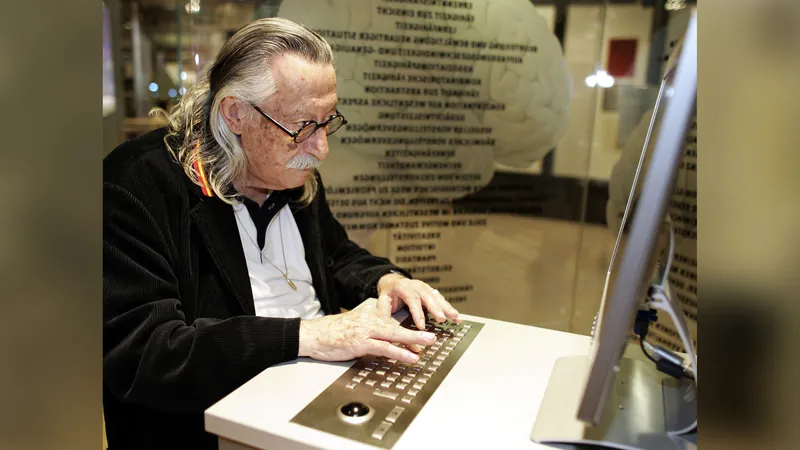
ELIZA: The Groundbreaking Chatbot Resurrected After 60 Years!
2025-01-18
Author: Li
A Technological Revival
In an astonishing technological revival, scientists have successfully brought back "ELIZA," the pioneering chatbot that marked a significant milestone in artificial intelligence (AI), from decades-old computer code. This remarkable feat was achieved using dusty printouts unearthed from MIT archives, showcasing the tireless efforts of modern "software archaeologists."
The Origins of ELIZA
Originally created in the 1960s by MIT researcher Joseph Weizenbaum, ELIZA was named after Eliza Doolittle, the central character of George Bernard Shaw's play "Pygmalion." In the play, Eliza learns to speak with upper-class sophistication, mirroring how ELIZA was designed to engage users in conversation much like a psychotherapist. For instance, if prompted with "Men are all alike," ELIZA would deftly respond, "In what way?" This interaction revealed the chatbot’s ability to provide a semblance of understanding, paving the way for contemporary AI.
The Code Behind ELIZA
ELIZA was coded in an early programming language developed by Weizenbaum called Michigan Algorithm Decoder Symmetric List Processor (MAD-SLIP), though it was quickly transcribed into the more widely used Lisp language. As digital communication evolved, the Lisp version of ELIZA gained significant traction, overshadowing the original code, which seemed lost to history.
The Rediscovery of ELIZA
However, the past came alive in 2021 when cognitive scientist Jeff Shrager from Stanford University, alongside MIT archivist Myles Crowley, stumbled upon the original 420-line code within Weizenbaum's papers. Shrager expressed his fascination with understanding the thought processes of early AI pioneers, stating that preserving their code provides invaluable insights into their intellectual landscape.
Challenges in Reanimating ELIZA
Reanimating ELIZA was no small task. Researchers faced the challenge of cleaning up and debugging the vintage code, as well as developing an emulator that could mimic the computing environment of the 1960s. On December 21, after meticulous work, ELIZA was successfully revived for the first time in 60 years, confirming its authenticity and impressive functionality.
Preserving Authenticity
Interestingly, the team discovered a bug in the original code causing it to crash when a user inputted a number. Rather than fixing this glitch, they opted to retain it for the sake of authenticity—comparing the decision to preserving a minor flaw in an artwork like the Mona Lisa. Despite its limitations compared to today’s advanced large language models, ELIZA's historical significance has drawn fresh comparisons to the AI of today.
Insights from the Revival
"In terms of conversation, ELIZA had an edge," Shrager noted, emphasizing its ability to listen and encourage dialogue. While modern chatbots often focus on completing sentences, ELIZA engaged users by prompting them to share more, an essential aspect of meaningful conversation.
The Importance of Preservation
Bringing ELIZA back into the spotlight offers a crucial reminder of how far technology has come while also highlighting the importance of preserving technological history. David Berry, a digital humanities researcher, stressed the need for society to maintain these records, likening the loss of early computing history to the disappearance of famed cultural artifacts.
Berry aptly stated, “If we don’t preserve these digital relics, we risk losing the equivalent of the Mona Lisa or Michelangelo's David.” The resurrection of ELIZA is not just about reviving a piece of code; it’s a poignant reminder of our past and the foundations on which modern AI stands today.


 Brasil (PT)
Brasil (PT)
 Canada (EN)
Canada (EN)
 Chile (ES)
Chile (ES)
 Česko (CS)
Česko (CS)
 대한민국 (KO)
대한민국 (KO)
 España (ES)
España (ES)
 France (FR)
France (FR)
 Hong Kong (EN)
Hong Kong (EN)
 Italia (IT)
Italia (IT)
 日本 (JA)
日本 (JA)
 Magyarország (HU)
Magyarország (HU)
 Norge (NO)
Norge (NO)
 Polska (PL)
Polska (PL)
 Schweiz (DE)
Schweiz (DE)
 Singapore (EN)
Singapore (EN)
 Sverige (SV)
Sverige (SV)
 Suomi (FI)
Suomi (FI)
 Türkiye (TR)
Türkiye (TR)
 الإمارات العربية المتحدة (AR)
الإمارات العربية المتحدة (AR)